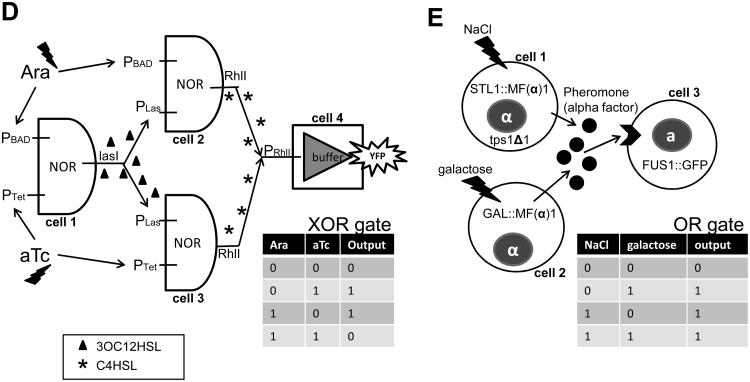Figure 3.
Engineering one-way cell-cell communication.
(A) A synthetic pulse-generator. It consists of one-way communication between the sender and the receiver by a QS mechanism. In the sender cells, upon aTc induction, LuxI synthesizes the autoinducer 3OC6HSL. The receiver cells include a feed-forward network comprised by two arms of regulation: in the first arm, the LuxR-3OC6HSL complex (LuxR*) activates expression of repressor CI, which in turn represses GFP expression; in the second arm, LuxR* induces GFP expression. Figure adapted from Basu et al. [47].
(B) Synthetic self-organized pattern formation. The sender cells produce 3OC6HSL upon induction by aTc. The receiver contains a feed-forward network with two arms: in the first, LuxR* activates expression of a mutated LacI (LacIM1), which then inhibits the output of the circuit, GFP; in the second arm, LuxR* activates expression of the repressor CI, which inhibits expression of LacI; LacI further inhibits GFP expression. The receiver cells are thus conferred with the function of concentration-band detection. Figure adapted from Basu et al. [48].
(C) Simpson's paradox demonstrated by a synthetic microbial ecosystem consisting of QS signal (C4HSL) producers (P) and non-producers (NP). In P, promoter PR drives the synthesis of autoinducer synthase (RhlI), which produces C4HSL. C4HSL diffuses across cell membranes and binds the constitutively expressed RhlR to form an activated complex RhlR-C4HSL (R*). This complex in turn drives expression of catLVA, which confers cells with chloramphenicol resistance. The sdiA null background (sdiAΔ) reduces other Rhl-independent gene expression. In the NP strain, the rhlI gene is absent. The P (with GFP) and NP (no GFP) strains can be differentiated by GFP. Figure adapted from Chuang et al. [51].
(D) An XOR logic gate utilizing cell-cell communication between colonies on a plate. It includes four colonies spatially distributed on an agar plate, in which three colonies contain NOR gates and one contains a buffer gate. The four colonies are spatially arranged such that the computation progresses from left to right; that is, the later layer receives QS signal from the previous layer, thus realizing the function of a XOR logic gate via cell-cell communication. Ara and aTc are inputs. The output of the XOR gate is a yellow fluorescent protein (YFP). Figure adapted from Tamsir et al. [52].
(E) An engineered yeast microbial consortium which utilizes cell-cell communication to achieve the OR logic gate. The microbial consortium includes three cell strains. Two cells receive input stimuli of NaCl and galactose, respectively, and consequently produce the yeast pheromone alpha-factor as a signaling molecule for cell-cell communication in the microbial consortium. The alpha-factor in turn induces GFP expression in the output cell. Figure adapted from Regot et al. [53].


